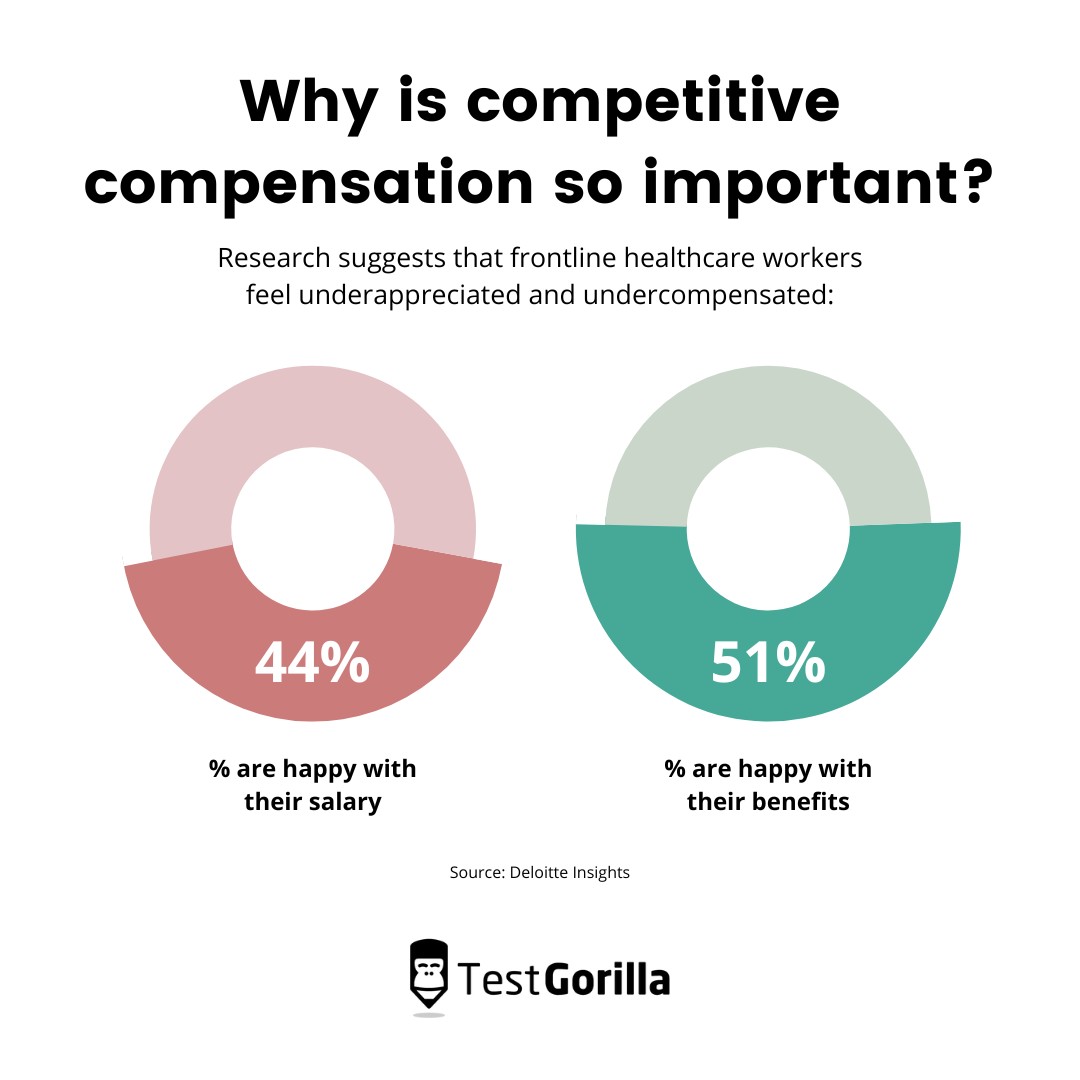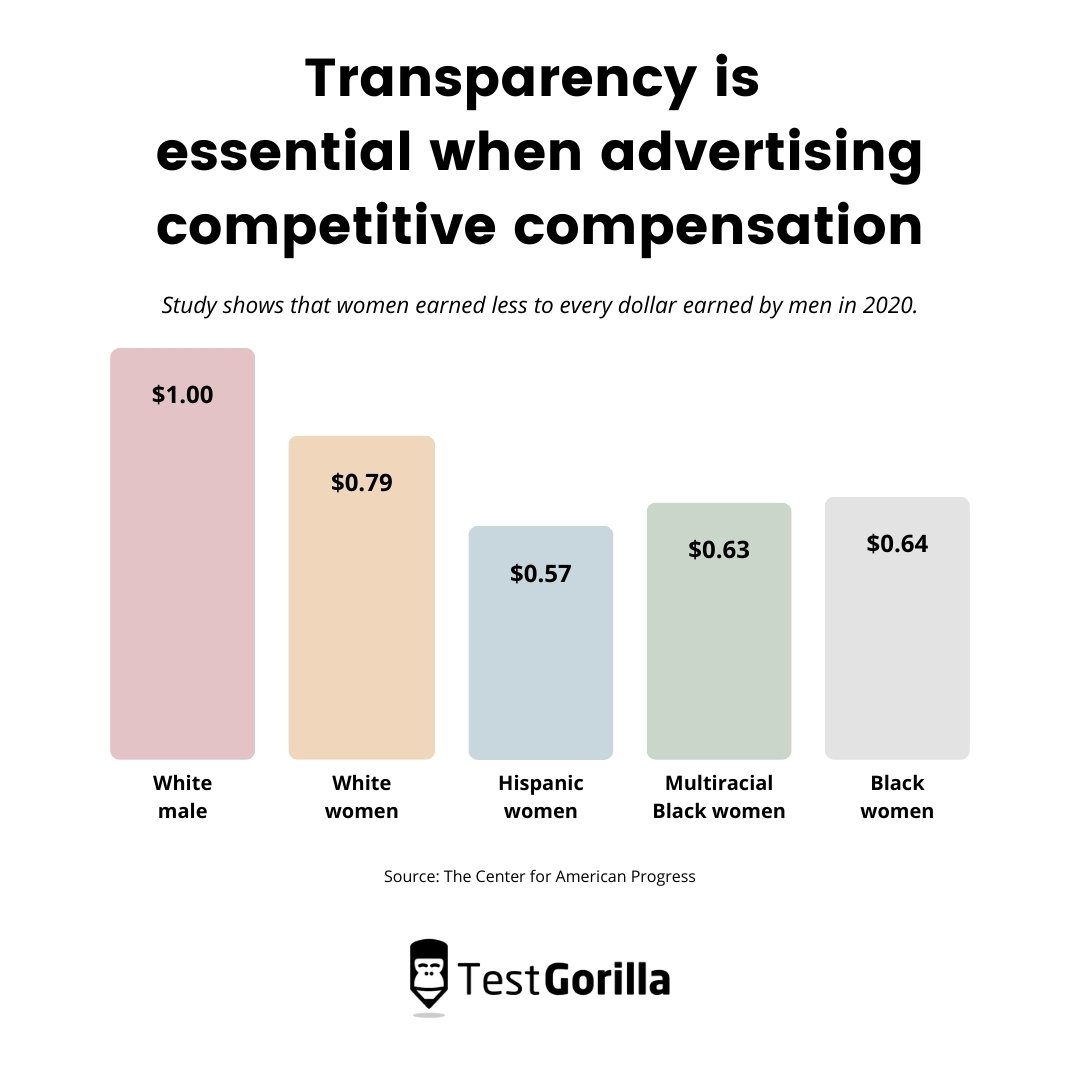In a Glassdoor survey, 67% of employees cited salary as a top factor they look for in ads for open jobs. Salary easily outranked location, commute time, and employee reviews in importance. (1)
But it just barely outranked benefits, which 63% of employees deemed to be important.
The message is clear: Employees want competitive compensation packages. And they’re prepared to disregard jobs that don’t offer a fair rate of pay.
Even if your company is taking every possible measure to hire the best of the best – from targeted recruiting to candidate skills testing – it could still be missing out on qualified candidates by failing to offer competitive compensation.
In this guide to competitive compensation and benefits packages, we explore what competitive compensation is, why it matters, and how to calculate a competitive rate of pay. We also examine other factors to help you attract talent.
Table of contents
- What is competitive compensation?
- Why is competitive compensation so important?
- How to determine competitive compensation for a position
- How to advertise your competitive compensation: The key is transparency
- Competitive compensation alone is not enough to attract and retain top talent: 6 other crucial factors to consider
- Build a competitive compensation package to secure top talent
- Sources
What is competitive compensation?
Competitive compensation is the pay that employees receive for their work. It includes both direct pay, like an employee’s base salary, and indirect pay, like additional benefits.
To be competitive, a compensation package has to be equal to or better than the compensation offered by a company’s market competitors. The aim of a competitive compensation package is to attract top talent to your company and away from other potential employers.
A strong compensation package can make all the difference to workers. In fact, 63% of employees who quit jobs in 2021 cited low pay as a factor influencing their decision.
What’s included in a competitive compensation and benefits package?
A competitive compensation and benefits package may include some or all of the following elements:
Base salary
Bonuses
Paid time off (PTO)
Flexibility (including remote work options)
Training and career development opportunities
Stock options
Traditional benefits (like a pension and health insurance)
Dental and vision insurance
It’s important to remember total compensation isn’t all about offering a competitive salary. Although a high wage can be eye-catching at first glance, a Forbes survey shows that one in 10 employees would take a pay cut to access better employee benefits.
To be truly competitive, a compensation package needs to offer high value overall – not just competitive pay.
Why is competitive compensation so important?
When you offer competitive compensation, you put yourself in the best position to attract and retain top talent.
That’s essential because talent is in short supply.
In its 2023 Global Talent Shortage survey, Manpower found that 77% of employers are finding it difficult to fill open roles, an unprecedented 17-year high.
This is a particular problem in healthcare, which has been severely affected by the long-term stress of the pandemic.
Research suggests that frontline healthcare workers feel underappreciated and undercompensated: Just 44% are happy with their salary, while only 51% are happy with their benefits.[2]
But it’s also an issue in blue-collar industries like manufacturing, food service, and hospitality. According to the US Chamber of Commerce, the accommodation and food services industry has maintained an employee quit rate above 5% since July 2021.
The same research shows that even if they employed every currently unemployed person with experience in durable goods manufacturing, the industry would only be able to fill 44% of its vacant positions.
Retaining your top performers has never been more challenging or more important. But fair and competitive compensation goes a long way toward encouraging them to stay with your company.
Good employees are any company’s most significant asset. You need to put them first, treat them with respect, and invest in their wellbeing and development. Competitive compensation is part of that. It reflects the value you place on the work they do for you.
How to determine competitive compensation for a position
So how can you put a value on an employee’s work?
The key to competitive compensation is that it’s competitive, which means it has to be based on evidence, industry standards, and market research.
Here’s what you need to consider when evaluating an employee’s pay and benefits package.
The factors that influence pay and benefits
There’s no one-size-fits-all approach to building a competitive compensation package. You need to evaluate every aspect of the role you’re hiring for and the candidate you want to hire, as well as market factors impacting your industry.
These are the factors you need to consider and the ways they can influence your compensation pay rates.
The factor | How it influences compensation |
Job title | Job titles often have a market rate baseline you need to meet or exceed |
Employee skill level | Employees with more (or more relevant) skills expect to be paid more |
Scarcity of skill set | If your employee’s skills are in high demand, you need to offer better pay |
Industry | Average rates of pay vary between industries, so you need to compete with other companies in your field |
Geographic location | Places with a higher cost of living need to offer a better compensation package |
When hiring for roles where candidates are in short supply, employers need to offer more to attract talent |
The HR resources you can turn to
The most wide-ranging resource to help you calculate a compensation package is the US Bureau of Labor Statistics. It’s a federal government agency that compiles and manages information about the labor market in the US.
It’s especially useful as a benchmark when considering rates of pay because it offers data on the annual mean wages for a huge variety of roles, industries, and sectors. You can even filter the data by location to determine the average rate of pay in your local area.
For example, if you wanted to find information on the average salary for a newly hired data analyst in your local area, here’s what you can do:
In the “Subjects” menu, select “Wage Data by Occupation”
Select “OEWS Data” and then “Databases”
Choose the format of your data (the Data Finder and One Screen options are easiest to navigate)
Input the criteria of your search (for example, the job title “Data Analyst” and your company’s geographical location)
Review the data
You can then use this data to calculate a salary comp ratio for your data analyst. The ratio helps you figure out where an employee’s proposed pay falls within a certain range.
Remember that if your proposed salary is on the lower end of the range, you need to offer extra benefits to stay competitive.
To stay organized when planning your salary and compensation budget, consider using compensation management software. These tools help human resource departments streamline salary planning and monitor a company’s rates of pay at a glance.
When adjusting pay for existing employees, it’s worthwhile to draw on information from a company-wide talent review. This data shows you which employees have particularly valuable skills and which employees may need further access to training and development.
How to advertise your competitive compensation: The key is transparency
When advertising an open role, remember that “competitive compensation” is a concept. It’s not a concrete rate of pay, and it doesn’t help candidates gauge what you plan to pay them.
That’s why you should never list “competitive compensation” as a salary when advertising a job. Pay transparency is increasingly important to applicants.
If you aren’t prepared to list an actual salary range (along with any benefits) in your job descriptions, then you can’t expect to attract the best candidates.
Being open about a position’s compensation also saves time for both managers and job applicants. It ensures all parties have clear expectations of the position from the beginning of the hiring process, and they can decide whether to proceed or not.
This really does matter to employees – especially Gen Z. In a recent survey from Adobe, 85% of Gen Z workers reported they would be less likely to apply for a job that didn’t include a salary range in its listing.
That may explain why the number of job postings that include salary information has more than doubled since 2020, with 43.7% of listings now featuring rates of pay.
Transparency around compensation is also a way for your organization to live out its values of diversity and inclusion. Without that transparency, it’s easier for companies to get away with paying marginalized employees less for their work.
For example, research by American Progress shows that in 2020, White women earned $0.79 for every dollar earned by their White male counterparts. The discrepancy was even worse for women of color, with the lowest earners as follows:[3]
Hispanic women ($0.57)
Multiracial Black women ($0.63)
Black women ($0.64)
Being forthright about salary encourages these marginalized groups to apply by giving them confidence in the fairness of their earnings. It’s a simple, effective way to build inclusivity into your organization from the moment you advertise a role.
Competitive compensation alone is not enough to attract and retain top talent: 6 other crucial factors to consider
Market-competitive compensation is vital when competing with other businesses to acquire top talent.
But employees don’t base their decisions on compensation alone – there are other factors at play that can influence a candidate’s decision to take or leave a job offer.
Here are the issues you need to stay on top of if you want your company to stay as competitive as possible when recruiting.
Attracting talent at a glance
What to consider | How it helps |
Company culture | Creates an environment where employees feel appreciated, welcomed, and respected |
Career opportunities | Prevents top talent from looking elsewhere for career advancement |
Flexibility | Shows respect for workers’ personal lives and needs |
Work-life balance | Ensures that staff feel supported and cared for, creating a healthy company culture |
Quality of leadership | Limits voluntary turnover and loss of talent stemming from issues with management |
Business outlook | Offers long-term growth and development opportunities for employees |
1. Company culture
The Great Resignation has left employers scrambling to fill skill gaps and secure the talent they need – and the number-one cause of employee turnover during the Great Resignation is a toxic company culture.
Even if the labor market stabilizes as we move further into 2023, it’s vital for businesses to address the root causes of employee dissatisfaction to avoid similar upheaval in the future.
So how can you fix a company culture that may be alienating potential new hires? Here are a few steps you can take to build a more appealing culture:
Analyze your existing culture and identify areas for improvement
Ask your employees which aspects of company culture are most important to them
Decide on your company’s core values and enshrine them in policy
Integrate those values into your appreciation and reward programs
Hire for culture add and build a workforce that lives your company’s values
It’s important to be intentional as you develop your workplace culture, especially if your employees are remote or hybrid workers. Aim to build a cohesive culture that puts everyone – from managers to interns – on the same page regardless of where they work from.
2. Career opportunities
More than 50% of employees say that it’s easier to find a new role elsewhere than to move to another role within their current company. That’s a huge blow to companies who want to retain talented staff.
If employees see better career opportunities elsewhere, there’s a real chance they will leave your company to pursue them. This voluntary turnover isn’t just expensive – it also does damage to your business’s knowledge base, talent pool, and employee morale.
And whenever you have to replace a candidate, you run the risk of mis-hiring. Hiring the wrong person for a role leads to internal disruption and extra expense, as well as a lot of wasted time.
Avoid these problems by giving employees scope for internal mobility within your company. Here’s how to do it:
Build an internal talent marketplace to match employees to internal opportunities
Offer upskilling opportunities to your workforce, including management training
Be open to a career portfolio approach and accommodate the lateral moves your employees want to make
Resist the temptation to hoard talent on one team
Take a skills-first approach and prioritize internal candidates with the tools to succeed
Advertise positions internally first and only head to the external job market when necessary
All of these steps help you with long-term retention of your talent.
3. Flexibility
The pandemic introduced both employees and employers to remote working on a grand scale. Now, with the world continuing to adapt to Covid-19, many employees have developed a new appreciation for flexible work with remote and hybrid arrangements.
More than ever, it’s important to employees to have control over when, where, and how they work. For example, a 2022 survey revealed that the top five most desirable benefits for employees are:[4]
A company-sponsored retirement plan or pension (74.9%)
Flexible hours (74.2%)
An early finish on Fridays (63.9%)
A four-day work week (63.4%)
Family health insurance (62.3%)
Employees find flexibility to be just as valuable as long-term benefits like retirement plans and insurance policies – that’s how seriously they take it. Employers can get ahead in the race for talent by respecting that desire for flexibility.
In particular, offering to accommodate caring needs or family emergencies is a great way to bolster the diversity of your workforce because these policies are especially helpful to women in business.
Of course, it’s important to consider your own operational needs when offering flexibility to employees. Some businesses may need to stay open five days a week, while others may rely on fixed hourly work patterns to stay profitable.
But going the extra mile to accommodate your employees’ lives will make you a popular choice for the very best candidates.
4. Work-life balance
In a 2022 survey, 63% of employees said they would value work-life balance over better pay.
As we’ve seen, flexibility is a big part of work-life balance. But it isn’t the whole story. Employees are looking for not only the freedom to lead their personal lives but also ways to integrate it with their professional commitment.
This means that when deciding to accept a job, they value factors such as:
A culture of psychological safety
A culture of appreciation and recognition
Clear boundaries around work hours and obligations
Respect for employees’ health and wellness
Support for employees’ family choices and responsibilities
Fortunately, it’s easy for employers to build an appreciation for work-life balance into a competitive compensation package.
Benefits like paid time off, parental leave, and an employee assistance program are common and show respect for the ways a job can impact an employee’s personal life.
And to be even more competitive, some employers offer less traditional benefits to foster a good work-life balance.
For example, companies can support employees’ mental health by offering therapy sessions, mental health app subscriptions, meditation and yoga sessions, and scope to take mental health days off from work.
5. Quality of leadership
It’s a common truism in the world of work that employees don’t leave companies – they leave managers.
Employees who feel bullied by their managers or who simply don’t trust them are more likely to leave their jobs. Failure to deal with problematic managers is a highly preventable way for companies to lose out on the best talent.
In particular, workers with misgivings about the quality of their leadership are prone to quiet quitting.
This behavior stems from dissatisfaction and disengagement at work, and it’s costly for employers – who continue to pay wages to quiet quitters without reaping the real benefits of their skills and talents.
You can address problems with the quality of your company’s managers by taking the following steps:
Create transparent reporting processes for employees with concerns about their management
Conduct regular 360 evaluations of managers
Use the Leadership and People Management test to hire the best managers
To encourage trust and re-engagement at work, consider implementing engagement initiatives like team-building events or team parties.
Remember, employees who leave companies often talk about their experiences with their peers.
If your company develops a reputation for low-quality leadership, it could do real damage to your employer brand and impact your ability to attract the best candidates in future.
6. Business outlook
Is your company likely to grow and expand in the near future? If so, it may represent a more attractive prospect for the most talented candidates.
Fast-growing companies like startups are appealing to employees. In fact, 85% of American workers say the growth of their company is important to them.[5]
Candidates want to contribute to that growth. It’s a way to put their skills to use and stay engaged at work.
Growing businesses also offer more opportunities for employees to pursue internal mobility, learn on the job, and leave a lasting impression on company policy and culture.
By getting involved with the company on the ground floor, they set themselves up to make a big impact as it develops.
On the other hand, if your organization feels stagnant, employees may be less tempted – even by a more competitive compensation package. As we’ve seen, engagement matters, and employees who don’t feel their work has meaning are more likely to walk away.
When hiring to fill roles within a growing company, it’s important to hire workers who believe in your business’s vision. Use the Motivation test during hiring to make sure everyone’s expectations and values are in alignment.
Build a competitive compensation package to secure top talent
A competitive compensation package is a vital part of any job offer. It lets employees know how highly you value their talent, skills, and ability to contribute to your company’s vision.
Misjudging your compensation package signals to job seekers that you don’t appreciate them. It creates the risk you’ll lose them to more competitive offers from other companies.
And among your existing employees, poor compensation can lead to decreased engagement, low morale, and spiraling levels of voluntary turnover. That’s especially true for your most talented employees, who know they can find better offers elsewhere.
To attract and retain the very best in your field, you need to build a compensation package that makes your company stand out.
Next, learn more about attracting talent during the Great Reshuffle with skills-based hiring methods – including our popular Culture Add test.
Sources
“Glassdoor Study Reveals What Job Seekers Are Looking For”. (July 25, 2018). Glassdoor. Retrieved April 14, 2023. https://www.glassdoor.com/employers/blog/salary-benefits-survey/
Medlock, Maureen; et al. “Addressing health care’s talent emergency”. (November 15, 2022). Deloitte Insights. Retrieved April 14, 2023. https://www2.deloitte.com/us/en/insights/industry/health-care/healthcare-workforce-shortage-solutions.html
Bleiweis, Robin; Frye, Jocelyn; Khattar, Rose. “Women of Color and the Wage Gap”. (November 17, 2021). The Center for American Progress. Retrieved April 14, 2023.
“The future of employee benefits”. (n.d.). Remote. Retrieved April 14, 2023. https://remote.com/future-employee-benefits
“The Business Growth Report”. (n.d.). Kimble. Retrieved April 14, 2023. https://www.kimbleapps.com/resources/dach-business-growth-report/
Related posts
Hire the best candidates with TestGorilla
Create pre-employment assessments in minutes to screen candidates, save time, and hire the best talent.
Latest posts
The best advice in pre-employment testing, in your inbox.
No spam. Unsubscribe at any time.

Hire the best. No bias. No stress.
Our screening tests identify the best candidates and make your hiring decisions faster, easier, and bias-free.
Free resources
This checklist covers key features you should look for when choosing a skills testing platform
This resource will help you develop an onboarding checklist for new hires.
How to assess your candidates' attention to detail.
Learn how to get human resources certified through HRCI or SHRM.
Learn how you can improve the level of talent at your company.
Learn how CapitalT reduced hiring bias with online skills assessments.
Learn how to make the resume process more efficient and more effective.
Improve your hiring strategy with these 7 critical recruitment metrics.
Learn how Sukhi decreased time spent reviewing resumes by 83%!
Hire more efficiently with these hacks that 99% of recruiters aren't using.
Make a business case for diversity and inclusion initiatives with this data.





















